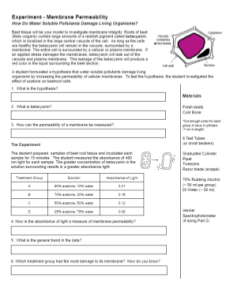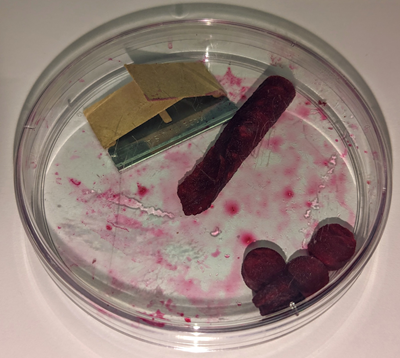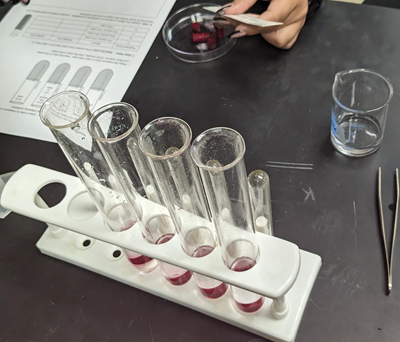
Beet tissue will be your model to investigate membrane integrity. Roots of beet (Beta vulgaris) contain large amounts of a reddish pigment called betacyanin, which is localized in the large central vacuole of the cell. As long as the cells are healthy the betacyanin will remain in the vacuole, surrounded by a membrane.
The entire cell is surrounded by a cellular or plasma membrane. If an applied stress damages the membranes, betacyanin will leak out of the vacuole and plasma membrane. This leakage of the betacyanin will produce a red color in the liquid surrounding the beet section.
What kinds of things cause stress to the cell?
Pollutants in the water, like alcohol or acetone, can cause the the pink betacyanin to leak out of the membrane. Color changes in the solution indicate the weakening of the membrane. In this lab, students will expose beet cores to different concentrations of alcohol and record the color change in the surrounding solution. Generally, I do this lab with my older, AP Biology students. It is included with a unit on the cell and cell membrane.
Overview of the Experiment
In the first section of the lab, students read background information on beets. They analyze data showing how the absorbance of light changes at different concentrations of acetone. In general, the greater concentration of acetone, the darker the solution of betacyanin.
In the second part of the lab, students cut disks from a beetroot core (about 1 cm). I use a cork borer to make cylinders, then the students use a razor blade or scalpel to cut each cylinder into 1 cm sections. You can distribute the materials in a petri dish which can contain some of the mess. Warning, the betacyanin from beetroot can stain clothes and skin.

Students place their beetroot disks into test tubes containing different concentrations of alcohol. I use test tubes, but you could also substitute cups or beakers. The instructions include how to dilute the alcohol, starting with a 70% isopropyl alcohol solution. This is the concentration of alcohol that can be purchased cheaply at drug stores. Basically, students add water to dilute the solution to 25%. They will use a control solution of just water to compare results.
Analyzing Data
Students will rank the color of the solution from dark red to light pink. This type of qualitative data is easy to obtain if you don’t have expensive equipment to measure light absorbance. Generally, students will be able to see a darker color of pink when the alcohol concentration is high.
If you have access to a spectrophotometer, students can gather quantitative data showing the absorbance of light. In the second part of the lab, students design their own experiment to test other types of stress, such as heat. They gather data and write a lab report that outlines their procedure, results, and conclusions.


